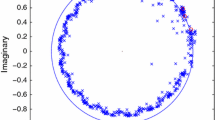Abstract
In this paper, we consider the order estimation problem of a 2-dimensional complex superimposed exponential signal model in presence of additive white noise. We use the recently proposed exponentially embedded family (EEF) rule (see Stoica and Babu in IEEE Signal Process Lett 19(9):551–554, 2012; Kay in IEEE Trans Aerosp Electron Syst 41(1):333–345, 2005) for estimating the order of the 2-dimensional signal model and prove that the EEF rule based estimator is consistent in large sample scenario. Extensive simulations are performed to ascertain the performance of the order estimation rule and also to compare the finite sample performance of EEF rule based estimator with other popular order selection rules using simulation examples.






Similar content being viewed by others
Explore related subjects
Discover the latest articles, news and stories from top researchers in related subjects.References
Agrawal, Shruti, Mitra, Sharmishtha, & Mitra, Amit. (2018). Estimating the order of multiple sinusoids model using exponentially embedded family rule: Large sample consistency. Signal Processing, 147, 54–59.
Akaike, H. (1974). A new look at the statistical model identification. IEEE Transactions on Automatic Control, 19(6), 716–723.
Chung, K. L. (2001). A course in probability theory. Cambridge: Academic Press.
Francos, J.M., & Kliger, M. (2005). Strong consistency of the over-and under-determined LSE of 2-D exponentials in white noise. In Proceedings IEEE International Conference on Acoustics, Speech, and Signal Processing, Vol. 4. IEEE.
He, S. (1995). Uniform convergence of weighted periodogram of stationary linear random fields. Chinese Annals of Mathematics, 16, 331–340.
Kay, S. (2005). Exponentially embedded families-new approaches to model order estimation. IEEE Transactions on Aerospace and Electronic Systems, 41(1), 333–345.
Kliger, M., & Francos, J. M. (2008). Strong consistency of a family of model order selection rules for estimating 2D sinusoids in noise. Statistics & Probability Letters, 78(17), 3075–3081.
Kundu, D., & Mitra, A. (1996). Asymptotic properties of the least squares estimates of 2-D exponential signals. Multidimensional Systems & Signal Processing, 7, 135–150.
Kundu, D., & Mitra, A. (1996). Asymptotic properties of the least squares estimates of 2-D exponential signals. Multidimensional Systems and Signal Processing, 7(2), 135–150.
Kundu, D., & Mitra, A. (1999). On asymptotic properties and confidence intervals for exponential signals. Signal Processing, 72(2), 129–139.
Lehmann, E. L., & Romano, J. P. (2005). Testing statistical hypotheses. Berlin: Springer.
Li, J., Stoica, P., & Zheng, D. (1996). An efficient algorithm for two-dimensional frequency estimation. Multidimensional Systems and Signal Processing, 7, 151?178.
Mitra, A., & Stoica, P. (2002). The Asymptotic Cramer-Rao bound for 2-D superimposed exponential signals. Multidimensional Systems & Signal Processing, 13, 317–331.
Prasad, A., Kundu, D., & Mitra, A. (2008). Sequential estimation of the sum of sinusoidal model parameters. Journal of Statistical Planning and Inference, 138(5), 1297–1313.
Rao, C. R., Zhao, L., & Zhou, B. (1994). Maximum likelihood estimation of 2-D superimposed exponential signals. IEEE Transactions on Signal Processing, 42(7), 1795?1802.
Rissanen, J. (1982). Estimation of structure by minimum description length. In Rational Approximation in Systems Engineering. Birkhäuser Boston, pp. 395–406.
Rissanen, J. (1978). Modeling by shortest data description. Automatica, 14(5), 465–471.
Sakamoto, Y., Ishiguro, M., & Kitagawa, G. (1986). Akaike information criterion statistics. Dordrecht: D. Reidel.
Schwarz, G. (1978). Estimating the dimension of a model. The Annals of Statistics, 6(2), 461–464.
Stoica, P., & Babu, P. (2012). On the exponentially embedded family (EEF) rule for model order selection. IEEE Signal Processing Letters, 19(9), 551–554.
Stoica, P., & Babu, P. (2013). Model order estimation via penalizing adaptively the likelihood (PAL). Signal Processing, 93(11), 2865–2871.
Wilks, S. S. (1946). Sample criteria for testing equality of means, equality of variances, and equality of covariances in a normal multivariate distribution. The Annals of Mathematical Statistics, 17(3), 257–281.
Zhu, Z., & Kay, S. (2017). Estimate the degree of noncircularity of complex-valued vectors via exponentially embedded family. In Proceedings of IEEE Radar Conference, Seattle.
Zhu, Z., & Kay, S. (2018). On Bayesian exponentially embedded family for model order selection. IEEE Transactions on Signal Processing, 66(4), 933–943.
Author information
Authors and Affiliations
Corresponding author
Additional information
Publisher's Note
Springer Nature remains neutral with regard to jurisdictional claims in published maps and institutional affiliations.
Sharmishtha Mitra: Work partially supported by Research Project Grant MTR/2017/000208 of Science and Engineering Research Board, Government of India.
Rights and permissions
About this article
Cite this article
Porwal, A., Mitra, S. & Mitra, A. Order estimation of 2-dimensional complex superimposed exponential signal model using exponentially embedded family (EEF) rule: large sample consistency properties. Multidim Syst Sign Process 30, 1293–1308 (2019). https://doi.org/10.1007/s11045-018-0605-1
Received:
Revised:
Accepted:
Published:
Issue Date:
DOI: https://doi.org/10.1007/s11045-018-0605-1




